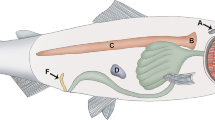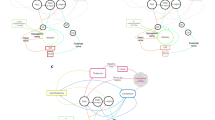Summary
The structure and histochemistry of the chondrichthyan testis is studied in young and adult male dogfish (Scyliorhinus caniculus). The development which parallels sexua maturation is described as well as the modality of an interruption of spermatogenesis as described by J. M. Dodd (1960). This interruption is possible in young and adult specimens provided that the sensitive stage exists in the testis. It includes the latest spermatogonial mitoses and lasts until the Sertoli cell's nuclei have achieved their migration. Its signification remains to be determined.
In the course of this work the stages of spermatogenesis have been listed, and previous papers have been reviewed and completed. — Each seminiparous ampulla grows out from a single gonocyte, and is surrounded by several follicle cells. After about twelve mitoses primary spermatocytes are formed. Each bundle built up by 64 spermatozoons is produced by a series of 6 synchronous cell multiplications (4 mitotic and 2 meiotic divisions) within one spermatogemma (La Valette St. George, 1878).
Spermatogenesis is finished when the periflagellar cytoplasmic sheath appears behind the middle piece. The various characteristical segments of the spermatozoon are the places of successive agglutinations.
The „problematical bodies“ in the Sertoli cells described by Semper (1875) appear as the precursor protein AF− granules confluence. AF+ granules at the base are not excreted, and after spermiation take part in the lysis of the epithelium. An acid metachromatic glycoprotein accumulates in the distal part of the cytoplasm. Spermiation causes the decay of this caducous cytoplasm carrying away spermatozoons and “problematic bodies”; however, basal cytoplasm and the nucleus are left at their place. No vacuoles are formed.
Taking recent results into consideration the influence of the hypophysis on spermatogenesis and on the secretion of testicular steroids is discussed. There are important differences between Chondrichthyans and other vertebrates.
Résumé
La structure et l'histochimie du testicule des Chondrichthyens ont été étudiées sur des mâles jeunes et adultes de Scyliorhinus caniculus (L.). L'évolution parallèle à l'acquisition de la maturité sexuelle est précisée, de même que les modalités de l'interruption de la spermatogenèse décrite par J. M. Dodd (1960). Cette interruption est possible chez le jeune comme chez l'adulte. Il suffit que le stade sensible correspondant existe. Il s'étend aux dernières mitoses spermatogoniales et dure jusqu'à l'achèvement de la migration nucléaire sertolienne. Sa signification reste imprécise.
En dressant la liste des stades de la spermatogenèse, on a revu les descriptions antérieures, incomplètes. Chaque ampoule séminipare dériverait d'une seule cellule germinale, entourée de plusieurs cellules folliculaires. Douze mitoses, environ, conduisent au spermatocyte I. Chaque faisceau de 64 spermatozoïdes est le produit de 6 divisions synchrones successives (4 mitoses + 2 divisions réductionelles) à l'intérieur d'une même spermatogemme.
La fin de la spermiogenèse est marquée par l'apparition du manchon cytoplasmique périflagellaire, en arrière de la pièce intermédiaire. Les divers segments caractéristiques de ce spermatozoïde sont le siège d'agglutinations successives.
Dans la cellule de Sertoli, le ≪corps problématique≫ de Semper (1875) apparaît aux dépens de granules précurseurs protéiques AF−, qui fusionnent. Des granules basaux AF+, non excrétés, participent à la lyse de l'épithélium après la spermiation. Le cytoplasme distal accumule une glycoprotéine acide, métachromatique. La chute de ce cytoplasme caduc détermine la spermiation en entraînant spermatozoïdes et corps problématique, le cytoplasme basal et le noyau restant en place. Il ne se forme pas de vacuoles.
L'action de l'hypophyse sur la spermatogenèse et sur la sécrétion des stéroïdes testiculaires est discutée à la lumière de travaux récents. Les Chondrichthyens présentent des différences importantes par rapport aux autres Vertébrés.
Similar content being viewed by others
Bibliographie
Balbiani, G.: Leçons sur la génération des Vertébrés, recueillies par le Dr. F. Henneguy. Paris 1879 (d'après Sabatier 1896).
Ballowitz, E.: Untersuchungen über die Struktur der Spermatozöen. Arch. mikr. Anat. 36, 225–290 (1890).
Battaglia, F.: Ricerche istologiche e istochimiche sul testicolo dei Selaci con spéciale riguardo alle cellule interstiziali. Riv. Biol. 7, 283–296 (1925).
Botte, V., G. Chieffi, and H. P. Stanley: Histological and histochemical observations on the male reproductive tract of Scyliorhinus stellaris, Torpedo marmorata and T. torpedo. Pubbl. staz. zool. Napoli 33, 224–242 (1963).
Broek, A. J. P. Van denxxx: Gonaden und Ausführungsgänge. In: Handbuch der vergleichenden Anat., par L. bolk et coll., Bd. 6, S. 1–154. Berlin: Urban & Scharzenberg 1932.
Bruch, E.: Etude sur l'appareil de la génération chez les Sélaciens. Strasbourg, 1860 (d'après Sabatier 1896).
Carlisle, D. B.: The effect of mammalian lactogenic hormone on lower chordates. J. Mar. Biol. Ass. U. K. 33, 65–68 (1954).
Chieffi, G.: Ricerche sul differenziamento dei sessi negli embrioni di Torpedo ocellata. Pubbl. staz. zool. Napoli 22, 57–78 (1949).
—: Sex differenciation and experimental sex reversal in Elasmobranch fishes. Arch. Anat. Morphol. exp. 48, 21–36 (1959).
—: F. Della corte e V. Botte: Osservazioni sul tessuto interstiziale del testicolo dei Selaci. Boll. Zool. 28, 211–217 (1961).
—: and C. Lupo: Identification of oestradiol-17β, testosterone and its precursors from Scylliorhinus stellaris testes. Nature (Lond.) 190, 169–170 (1961).
Collenot, G., et R. Ozon: Mises en évidence biochimique et histochimique d'une Δ 5−3 βhydroxystéroïde déshydrogénase dans le testicule de Scylliorhinus canicula L. Bull. Soc. zool. France 89, 577–587 (1964).
Della Corte, F., V. Botte e G. Chieffi: Ricercha istochimica dell'attività délla steroide-3 β-olo-deidrogenasi nel testicolo di Torpedo marmorata Risso e di Scyliorhinus stellaris (L.). Atti soc. peloritana Sci. fis. mat. nat. 7, 393–397 (1961).
Dodd, J. M.: Gonadal and gonadotrophic hormones in lower vertebrates. In: Marshall's Physiology of Reproduction, vol. 1, part 2, p. 417–582. London: Longmans Green 1960.
—, P. J. Evennett, and C. K. Goddard: Reproductive endocrinology in Cyclostomes and Elasmobranchs. Symp. Zool. Soc. London 1, 77–103 (1960).
Duijn, P. Vanxxx: Acrolein-Schiff, a new staining method for proteins. J. Histochem. Cytochem. 9, 234–241 (1961).
Evennett, P. J., and J. M. Dodd: Endocrinology of reproduction in the river lamprey. Nature (Lond.) 197, 715–716 (1963).
Fratini, L.: Osservazioni sulla spermatogenesi di Scylliorhinus canicula, Pubbl. staz. zool. Napoli 24, 201–216 (1953).
Grassé, P.-P., et O. Tuzet: Sur la spermiogenèse du Sélacien Scyllium canicula Cuv. C. R. Soc. Biol. (Paris) 111, 279–282 (1932).
Hallmann, E.: Über den Bau des Hodens und die Entwicklung der Samenthiere der Rochen. Arch. Anat. Physiol. wiss. Med. 1840, 467–474 (1840).
Hermann, F.: Beiträge zur Kenntnis der Spermatogenese. Arch. mikr. Anat. 50, 276–315 (1897).
Herrmann, G.: Sur la spermatogenèse chez les sélaciens. C. R. Acad. Sci. (Paris) 93, 858–860 (1881).
Jensen, O. S.: Recherches sur la spermatogenèse. Arch. Biol. (Liège) 4, 669–747 (1883).
Lallemand, F.: Observations sur le développement des zoospermes de la raie. Ann. Sci. Nat. Zool., 2e sér. 15, 257–262 (1841).
La Valette St. George, A. J. H. von: Inest. Dissertatio de spermatosomatum evolutione in plagiostomis. Bonn, 3-VIII-1878 (d'après Sabatier 1896).
Lison, L.: Histochimie et cytochimie animales, en 2 vol. Paris: Gauthirs-Villars 1960.
Makino, S.: The chromosomes of two Elasmobranch fishes. Cytologia (Tokyo) Fujii Jubilee vol. 867–876 (1937).
Marshall, A. J., and B. Lofts: The Leydig-cell homologues in certain teleost fishes. Nature (Lond. 177, 704–705 (1956).
Matthews, L. H.: Reproduction in the basking shark Cetorhinus maximus (Gunner). Phil. Trans. (B) 234, 247–316 (1950).
Matthey, R.: La formule chromosomique du Sélacien Scylliorhinus catula (Günth.). C. R. Soc. Biol. (Paris) 126, 388–389 (1937).
—: Les chromosomes des Vertébrés. Lausanne: F. Rouge 1949.
Mazza, F.: Note anatomo-istologiche sulla Chimaera monstrosa. Linn. Atti Soc. Lig. Sci. Nat. 6, 301–315 (1895).
Mellinger, J.: Les relations neuro-vasculo-glandulaires dans l'appareil hypophysaire de la Roussette, Scyliorhinus caniculus (L.) (Poissons Elasmobranehes). Thèse Sciences Strasbourg. Colmar: Imprimerie Alsatia 1963. Réimprimé dans: Arch. Anat. Histol. Embryol. norm. exp. 47, 1–201 (1964).
Moore, J. E. S.: On the germinal blastema and the nature of the so called ≪reduction division≫ in the cartilaginous fishes. Anat. Anz. 9, 547–552 (1894).
—: On the structural changes in the reproductive cells during the spermatogenesis of elasmobranchs. Quart. J. micr. Sci. 38, 275–313 (1895).
Oordt, G. J. Vanxxx, P. G. W. J. Vanxxx Oordt, and W. J. Vanxxx Dongen: Recent experiments on the regulation of spermatogenesis and the mechanism of spermiation in the common frog, Rana temporaria. In: Comparative Endocrinology, ed. A. Gorbman, p. 488–498. New York: J. Wiley & Sons Inc. 1959.
Policard, M. A.: Constitution lympho-myéloïde du stroma conjonctif du testicule des jeunes Rajidés. C. R. Soc. Biol. (Paris) 54, 148–150 (1902).
Racadot, J.: Sur la mise en évidence des types cellulaires adénohypophysaires par la méthode de Herlant au bleu d'alizarine acide. Bull. Micr. appl. 12, 16–20 (1962).
Rawitz, B.: Untersuchungen über Zellteilung. II. Die Teilung der Hodenzellen und die Spermatogenese bei Scyllium can. Arch. mikr. Anat. 53, 19–62 (1898).
Retzius, G.: Über einen Spiralfaserapparat am Kopfe der Spermien der Selachien. Biol. Untersuch., N. F. 10, 61–64 (1902).
—: Die Spermien der Selachier. Biol. Untersuch., N. F. 14, 79–88 (1909).
Sabatier, A.: De la spermatogenèse chez les Plagiostomes et chez les Amphibiens. C. R. Acad. Sci. (Paris) 94, 1097–1099 (1882).
—: Sur quelques points de la spermatogenèse chez les sélaciens. C. R. Acad. Sci. (Paris) 120, 47–50 et 205–208 (1895).
—: De la spermatogenèse chez les Poissons Sélaciens. Trav. Inst. Zool. Univ. Montpellier et Stat. Marit. Cette, N. S., Mém. no 4, 1–191(1896).
Sanfelice, F.: Spermatogenesi dei Vetebrati. Boll. Soc. Nat. Napoli (1888) (cit. par Sabatier 1896).
Schreiner, A., und K. E. Schreiner: Die Beifungsteilungen bei den Wirbeltieren. Ein Beitrag zur Frage nach der Chromatinreduktion. Anat. Anz. 24, 561–578 (1904).
—: Neue Studien über die Chromatinreifung der Geschlechtszellen. II. Die Beifung der männlichen Geschlechtszellen von Salamandra maculosa (Laur.), Spinax niger (Bonap.) und Myxine glutinosa (L.). Arch. Biol. (Liège) 22, 419–492 (1906).
Semper, C.: Das Urogenitalsystem der Plagiostomen und seine Bedeutung für das der übrigen Wirbelthiere. Arb. zool.-zoot. Inst. Würzburg 2, 195–509 (1875).
Simpson, T. H., R. S. Wright, and H. Gottfried: Steroids in the semen of the dog-fish (Squalus acanthias). J. Endocr. 26, 489–498 (1963).
Stanley, H. P.: Urogenital morphology in the Chimaeroid Fish Hydrolagus colliei (Lay and Bennett). J. Morph. 112, 99–128 (1963).
- Fine structure and development of the spermatozoan midpiece in the elasmobranch fish Squalus suckleyi. J. Cell Biol. 23, 88 A (1964).
Stannius, H.: Über die männlichen Geschlechtstheile der Buchen und Haien. Arch. Anat. Physiol. wiss. Med. 1840, 41–43 (1840).
Stephan, P.: Sur le développement de la cellule de Sertoli chez les Sélaciens. C. R. Soc. Biol. (Paris) 54, 773–775 (1902 a).
—: L'évolution de la cellule de Sertoli des Sélaciens après la spermatogenèse. C. R. Soc. Biol. (Paris) 54, 775–776 (1902b).
—: L'évolution des corpuscules centraux dans la spermatogenèse de Chimaera monstrosa. C. R. Soc. Biol. (Paris) 55, 265–267 (1903).
—: Recherches sur quelques points de la spermiogenèse des Sélaciens. Arch. Anat. micr. 6, 43–60 (1904).
Suzuki, B.: Notiz über die Entstehung des Mittelstückes der Samenfäden von Selachiern. Anat. Anz. 15, 125–131 (1898).
Swaen, A., et H. Masquelin: Etudes sur la spermatogenèse. Arch. Biol. (Liège) 4, 749–801 (1883).
Tuzet, O.: La spermatogenèse des Poissons. In: Traité de Zoologie, direct. P.-P. Grassé, t. 13, fasc. 3, Addenda, p. 2653–2657. Paris: Masson & Cie. 1958.
—, et Y. Cabanis: Becherches sur la spermiogenèse des Sélaciens: Scyliorhinus caniculus (L.), Squalus acanthias (L.), Mustelus canis Mitchill. Raja clavata L. Arch. Zool. exp. gén. 97, 19–31 (1959).
Vogt, C., et Pappenheim: Recherches sur l'anatomie comparée des organes de la génération chez les animaux vertébrés. Ann. Sci. natur. Zool. 12, 100–131 (1859).
Author information
Authors and Affiliations
Additional information
Nous remercions M. le Professeur R. Defretin (Faculté des Sciences de Lille) de l'accueil qu'il nous a réservé à l'Institut de Biologie Maritime et Régionale de Wimereux (Pas-de-Calais), qu'il dirige.
Rights and permissions
About this article
Cite this article
Mellinger, J. Stades de la spermatogenèse chez Scyliorhinus caniculus (L.): Description, données histochimiques, variations normales et expérimentales. Zeitschrift für Zellforschung 67, 653–673 (1965). https://doi.org/10.1007/BF00340330
Received:
Issue Date:
DOI: https://doi.org/10.1007/BF00340330




